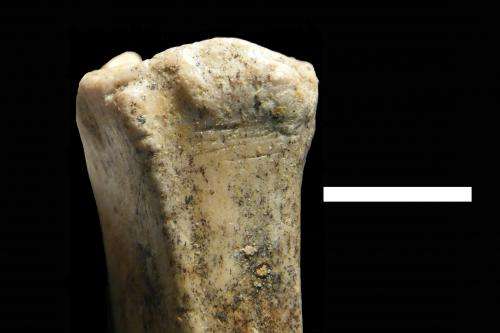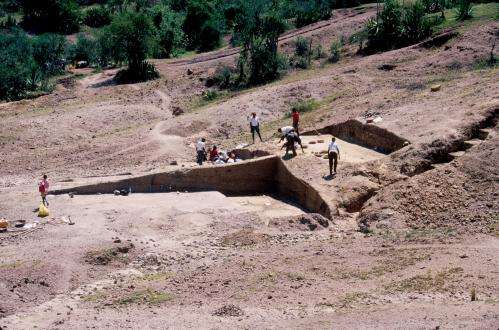Researcher finds earliest evidence of human ancestors hunting and scavenging

(Phys.org) —A recent Baylor University research study has shed new light on the diet and food acquisition strategies of some the earliest human ancestors in Africa.
Beginning around two million years ago, early stone tool-making humans, known scientifically as Oldowan hominin, started to exhibit a number of physiological and ecological adaptations that required greater daily energy expenditures, including an increase in brain and body size, heavier investment in their offspring and significant home-range expansion. Demonstrating how these early humans acquired the extra energy they needed to sustain these shifts has been the subject of much debate among researchers.
A recent study led by Joseph Ferraro, Ph.D., assistant professor of anthropology at Baylor, offers new insight in this debate with a wealth of archaeological evidence from the two million-year-old site of Kanjera South (KJS), Kenya. The study's findings were recently published in PLOS One.
"Considered in total, this study provides important early archaeological evidence for meat eating, hunting and scavenging behaviors -cornerstone adaptations that likely facilitated brain expansion in human evolution, movement of hominins out of Africa and into Eurasia, as well as important shifts in our social behavior, anatomy and physiology," Ferraro said.
Located on the shores of Lake Victoria, KJS contains "three large, well-preserved, stratified" layers of animal remains. The research team worked at the site for more than a decade, recovering thousands of animal bones and rudimentary stone tools.
According to researchers, hominins at KJS met their new energy requirements through an increased reliance on meat eating. Specifically, the archaeological record at KJS shows that hominins acquired an abundance of nutritious animal remains through a combination of both hunting and scavenging behaviors. The KJS site is the earliest known archaeological evidence of these behaviors.
"Our study helps inform the 'hunting vs. scavenging' debate in Paleolithic archaeology. The record at KJS shows that it isn't a case of either/or for Oldowan hominins two million years ago. Rather hominins at KJS were clearly doing both," Ferraro said.
The fossil evidence for hominin hunting is particularly compelling. The record shows that Oldowan hominins acquired and butchered numerous small antelope carcasses. These animals are well represented at the site by most or all of their bones from the tops of their head to the tips of their hooves, indicating to researchers that they were transported to the site as whole carcasses.
Many of the bones also show evidence of cut marks made when hominins used simple stone tools to remove animal flesh. Some bones also bear evidence that hominins used fist-sized stones to break them open to acquire bone marrow.

In addition, modern studies in the Serengeti—an environment similar to KJS two million years ago—have also shown that predators completely devour antelopes of this size within minutes of their deaths. As a result, hominins could only have acquired these valuable remains on the savanna through active hunting.
The site also contains a large number of isolated heads of wildebeest-sized antelopes. In contrast to small antelope carcasses, the heads of these somewhat larger individuals are able to be consumed several days after death and could be scavenged, as even the largest African predators like lions and hyenas were unable to break them open to access their nutrient-rich brains.
"Tool-wielding hominins at KJS, on the other hand, could access this tissue and likely did so by scavenging these heads after the initial non-human hunters had consumed the rest of the carcass," Ferraro said. "KJS hominins not only scavenged these head remains, they also transported them some distance to the archaeological site before breaking them open and consuming the brains. This is important because it provides the earliest archaeological evidence of this type of resource transport behavior in the human lineage."
More information: www.plosone.org/article/info%3Adoi%2F10.1371%2Fjournal.pone.0062174
Journal information: PLoS ONE
Provided by Baylor University


















